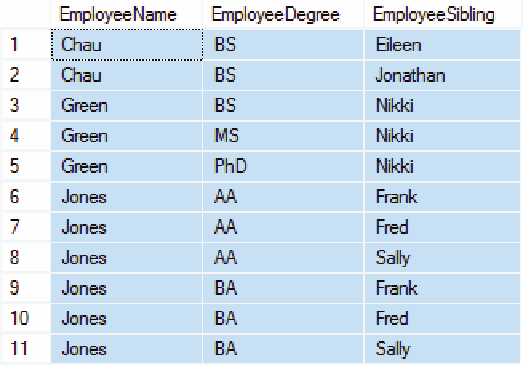Database Reference
In-Depth Information
EMPLOYEE_DEGREE_SIBLING
Figure 3-29
EMPLOYEE_DEGrEE_
SIBLING relation with two
Multivalued Dependencies
For example, consider the situation if we combine the employee data in Figure 3-28
into a single EMPLOYEE_DEGREE_SIBLING table with three columns (EmployeeName,
EmployeeDegree, EmployeeSibling), as shown in Figure 3-29.
Now, what actions need to be taken if employee Jones earns an MBA? We must add three
rows to the table. If we do not, if we only add the row ('Jones', 'MBA', 'Fred'), it will appear as if
Jones is an MBA with her brother Fred, but not with her sister Sally or her other brother Frank.
However, suppose Greene earns an MBA. Then we need only add one row ('Greene', 'MBA',
'Nikki'). But, if Chau earns an MBA, we need to add two rows. These are insertion anomalies.
There are equivalent modification and deletion anomalies as well.
In Figure 3-29, we combined two multivalued dependencies into a single table and ob-
tained modification anomalies. Unfortunately, we will also get anomalies if we combine a
multivalued dependency with any other column, even if that other column has no multivalued
dependency.
Figure 3-30 shows what happens when we combine the multivalued dependency
PartKitName
S
S
Part
with the functional dependency
PartKitName
S
PartKitPrice
PARTKIT_PART_PRICE
Figure 3-30
PartKIt_Part_PrICE
relation with a Functional
Dependency and a
Multivalued Dependency










Search WWH ::

Custom Search